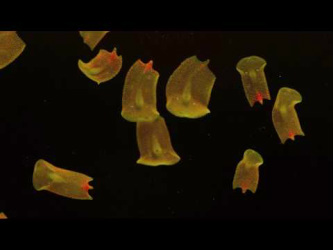Rust Brown Flatworms
Background:

The Rust Brown 'flatworm' is particularly common in the aquaculture industry. It is an acoel worm (see above), which, although quite flat, is only distantly related to the true flatworms belonging to the Phylum Platyhelminthes (which includes polyclads such as the AEFW, triclads as seen in the photo and thousands of parasitic species).
Causes:

These organisms are tan, brown or rust colored with a red dot, and reach a size of up to 1/4" in length. They are oval and slightly elongated with two tail-like appendages at their posterior. This brown acoel has been identified as Convolutriloba retrogemma, and will proliferate rapidly in aquariums with elevated nutrient levels. The populations of these pests can increase to a point where they will actually perch on corals, and block the light from reaching the corals' tissue. Some experts believe that the acoels actually feed on the zooxanthellae from coral tissue, thus damaging the corals themselves.
Management or Mitigation:

The best way of controlling acoels is by prevention. Maintaining low nutrient levels in the aquarium with the use of carbon and aggressive protein skimming, along with increased water flow will help to reduce the populations of these pests. Proper quarantine of new specimens, and all aquatic life before they are placed in the display aquarium will keep the initial introduction of acoels to a minimum.
Natural means of control include: Wrasses such as the Six Line Wrasse (Pseudocheilinushexataenia), Yellow Wrasse (Halichoeres. chrysus), Leopard Wrasse (Macropharyngodon sp.), and dragonets such as the Spotted Mandarin (Synchiropus picturatus). The Blue Velvet Nudibranch (Chelidonura varians) pictured here, is very effective at consuming acoels in the aquarium, but is very sensitive to changes in water chemistry and has a short life expectancy in the home aquarium.
Another method of removing acoels and flatworms from an infected colony is by performing a brief freshwater bath or dip. Acoels and flatworms are very sensitive to salinity changes; by dipping the colony in dechlorinated freshwater for 5 to 10 seconds and then shaking the colony while submerged in the bath of freshwater, will cause the worms to lose their grip and fall to the bottom of the container. Be sure the freshwater has the same temperature and pH as the aquarium's water in order to reduce the amount of stress on the colony.
The last method involves manual removal. Siphoning seems to work the best, as the acoels do not keep a very strong grip on the colony. A small diameter tubing works very well for soft leather coral colonies and some species of mushrooms. Be careful not to damage the coral with too strong of a siphon. For the more delicate mushrooms and LPS corals, small syringes work very well. It is possible to get the syringe very close to the acoel and gently draw the worm into the syringe without harming the coral.
Natural means of control include: Wrasses such as the Six Line Wrasse (Pseudocheilinushexataenia), Yellow Wrasse (Halichoeres. chrysus), Leopard Wrasse (Macropharyngodon sp.), and dragonets such as the Spotted Mandarin (Synchiropus picturatus). The Blue Velvet Nudibranch (Chelidonura varians) pictured here, is very effective at consuming acoels in the aquarium, but is very sensitive to changes in water chemistry and has a short life expectancy in the home aquarium.
Another method of removing acoels and flatworms from an infected colony is by performing a brief freshwater bath or dip. Acoels and flatworms are very sensitive to salinity changes; by dipping the colony in dechlorinated freshwater for 5 to 10 seconds and then shaking the colony while submerged in the bath of freshwater, will cause the worms to lose their grip and fall to the bottom of the container. Be sure the freshwater has the same temperature and pH as the aquarium's water in order to reduce the amount of stress on the colony.
The last method involves manual removal. Siphoning seems to work the best, as the acoels do not keep a very strong grip on the colony. A small diameter tubing works very well for soft leather coral colonies and some species of mushrooms. Be careful not to damage the coral with too strong of a siphon. For the more delicate mushrooms and LPS corals, small syringes work very well. It is possible to get the syringe very close to the acoel and gently draw the worm into the syringe without harming the coral.
